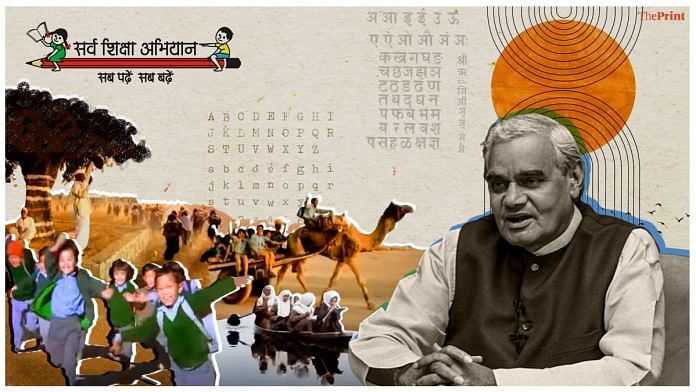New Delhi: Children clad in school uniforms racing past mountain streams and jumping over boulders. A gaggle of kids riding a camel-driven cart in the middle of a desert with a song on their lips — “School chalein hum“.
In the early 2000s, this song was heard playing on television sets with a regularity of no less than a daily news bulletin. Doordarshan drummed this message of ‘back to school’ just as the Atal Bihari Vajpayee government had wanted. It was, after all, the TV ad campaign of the former prime minister’s ‘Sarva Shiksha Abhiyan’ (Education for All Movement).
Savere, savere yaron se milne,
Bun-than ke nikle hum
Savere, savere, yaron se milne,
Ghar se door chalein hum
Roke se na ruke hum, Marzi sa chale hum
Baadal sa garje hum, Saavan sa barse hum
Sooraj sa chamke hum — school chalein hum
(In the morning, to meet friends
dressed up, we began to venture far from home
We won’t be stopped, we went on our own accord
Like clouds, we roar, like rain we pour
shining like sun, we’re off to school…)
The “School chalein hum” TV campaign was written by Mehboob and composed by Shankar/Ehsaan/Loy, and its words encapsulated precisely the ideals it aimed to promote — making primary education universally accessible in India.
The late Atal Bihari Vajpayee, too, puts in an appearance onscreen. The opening lines in the ad are his. He is seen smiling and gently calling children across the country to go to school along with him. “Children are going to school. We are also ready, let’s go to school together,” he says looking at two little students whom he pulls to his side with a smile.
Former president A.P.J. Abdul Kalam is also seen in the ad, instructing a group of school children surrounding him about the importance of knowledge gained through education.
Though education was made free and compulsory for children in the 6-14 year age group under the Right to Education Act passed in 2009, India’s literacy rate in 2001 was just 64.8 per cent according to the 2001 Census.
There was also a huge gap of 21.6 percentage points recorded between the male literacy rate (75.3 per cent) and female literacy rate (53.7 per cent) on a national scale. ‘Sarva Shiksha Abhiyan’ was intended to push the implementation of the Right To Education (RTE) Act and boost literacy rates, especially at the elementary level in India.
Also read: Takeshi’s Castle, a Japanese gameshow Indians took to heart thanks to Jaaved Jaaferi’s take-offs
Vajpayee’s Sarva Shiksha Abhiyan (SSA)
SSA was an extension of a previous initiative — the District Primary Education Programme (DPEP) — launched in 1994 by the Narasimha Rao government. SSA and DPEP had a shared objective which was to “revitalise and achieve universalisation of primary education.”
Interventions under SSA included opening new schools and alternative schooling facilities, construction of toilets and drinking water facilities in schools, provisioning for regular teachers, distributing free textbooks and uniforms among others.
SSA provided for 2.04 lakh primary and 1.59 lakh upper primary schools in India. An HRD ministry (now education ministry) official had told ThePrint that the reason for SSA’s success was its provision to check dropout rates in school and the efforts made by the government to retain vulnerable sections such as girl children and children from SC/ST categories, in particular.
By 2018-end, another scheme called ‘Samagra Shiksha Abhiyan’ was launched that subsumed Sarva Shiksha Abhiyan along with other centrally sponsored schemes like Rashtriya Madhyamik Shiksha Abhiyan (RMSA) and Teacher Education (TE). The goal of Sarva Shiksha Abhiyan to achieve its objectives by 2010 was also extended to 2020.
A long-lasting legacy
Without a doubt, the “School chalein hum” campaign had a long-lasting impact. The visuals of children rejoicing at the break of dawn, running off to school against the bright morning sun are still remembered years later.
From riding on camels covering the vast deserts of Rajasthan, trekking through snow-covered mountainous paths in Ladakh to running across paddy fields in India’s coastal regions, hope and delight was on all the young faces featured in the ad. It also served as an ad showcasing India’s diversity. That’s what made the campaign tune resonate with everyone in the country.
For many viewers, it made going to school a “beautiful experience,” while for others, it elicited a “hard-hitting nostalgia.”
For me and I think for many of the 90s kids Atal Behari Vajpayee made going to school look so beautiful with 'school chalein hum' played on doordarshan during those times.
— Geetasri Talukdar (@geetasriT) August 16, 2018
Hitting hard nostalgia man.❤️ And that voice of kunal is silky smooth. One of the best composition was made.
— Sargam ? (@sbareka445) May 11, 2021
If you can identify the song from this visual, you were probably growing up in the same time as I was. And probably had Doordarshan in those times to contend with as I had. And if you've identified the song, you can probably hear the words in your ears looking at this picture. pic.twitter.com/E6i8dT4SoA
— TheRandomCricketPhotosGuy (@RandomCricketP1) May 11, 2021
Its recall value was so high that Nestle India was prompted to recreate the iconic song in 2016 to bring attention to its corporate social initiative, aiming to impart education to underprivileged girl children across India. The original, however, packed more charm and remains a favourite still among Indians.
Shankar, Ehsaan & Loy recreate the magic of Bharat Bala’s iconic ‘School Chale Hum’ for Nestlé’s #EducateTheGirlChild campaign. pic.twitter.com/Oo2F5AWfHT
— Nestlé India (@NestleIndia) December 22, 2016
Nice but nothing compared to school chalein hum https://t.co/ktL1WXyHok
— Sw@dy (@jswady) December 23, 2016






